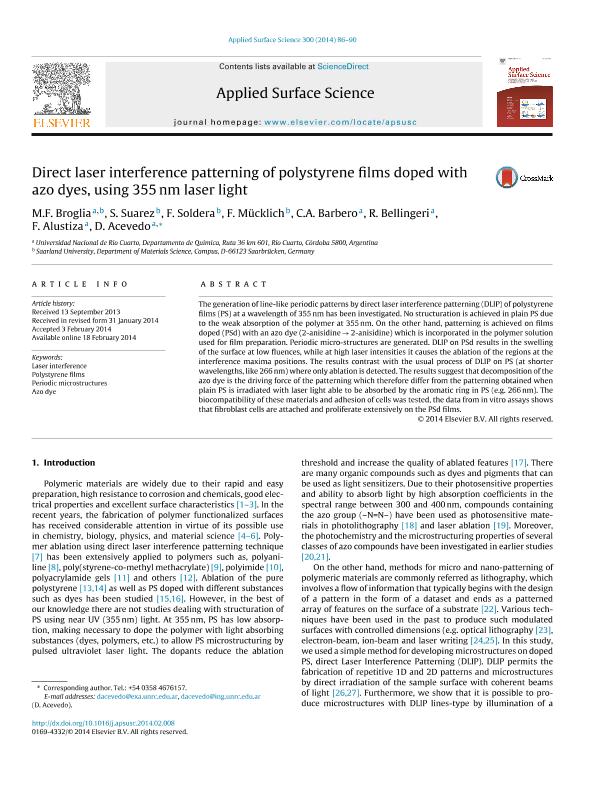Artículo
Direct laser interference patterning of polystyrene films doped with azo dyes, using 355 nm laser light
Broglia, Martin Federico ; Suarez, S.; Soldera, F.; Mücklich, F.; Barbero, César Alfredo
; Suarez, S.; Soldera, F.; Mücklich, F.; Barbero, César Alfredo ; Bellingeri, Romina Valeria
; Bellingeri, Romina Valeria ; Alustiza, Fabrisio Eduardo
; Alustiza, Fabrisio Eduardo ; Acevedo, Diego Fernando
; Acevedo, Diego Fernando
 ; Suarez, S.; Soldera, F.; Mücklich, F.; Barbero, César Alfredo
; Suarez, S.; Soldera, F.; Mücklich, F.; Barbero, César Alfredo ; Bellingeri, Romina Valeria
; Bellingeri, Romina Valeria ; Alustiza, Fabrisio Eduardo
; Alustiza, Fabrisio Eduardo ; Acevedo, Diego Fernando
; Acevedo, Diego Fernando
Fecha de publicación:
03/2014
Editorial:
Elsevier Science
Revista:
Applied Surface Science
ISSN:
0169-4332
Idioma:
Inglés
Tipo de recurso:
Artículo publicado
Clasificación temática:
Resumen
The generation of line-like periodic patterns by direct laser interference patterning (DLIP) of polystyrene films (PS) at a wavelength of 355 nm has been investigated. No structuration is achieved in plain PS due to the weak absorption of the polymer at 355 nm. On the other hand, patterning is achieved on films doped (PSd) with an azo dye (2-anisidine → 2-anisidine) which is incorporated in the polymer solution used for film preparation. Periodic micro-structures are generated. DLIP on PSd results in the swelling of the surface at low fluences, while at high laser intensities it causes the ablation of the regions at the interference maxima positions. The results contrast with the usual process of DLIP on PS (at shorter wavelengths, like 266 nm) where only ablation is detected. The results suggest that decomposition of the azo dye is the driving force of the patterning which therefore differ from the patterning obtained when plain PS is irradiated with laser light able to be absorbed by the aromatic ring in PS (e.g. 266 nm). The biocompatibility of these materials and adhesion of cells was tested, the data from in vitro assays shows that fibroblast cells are attached and proliferate extensively on the PSd films.
Palabras clave:
AZO DYE
,
LASER INTERFERENCE
,
PERIODIC MICROSTRUCTURES
,
POLYSTYRENE FILMS
Archivos asociados
Licencia
Identificadores
Colecciones
Articulos(CCT - CORDOBA)
Articulos de CTRO.CIENTIFICO TECNOL.CONICET - CORDOBA
Articulos de CTRO.CIENTIFICO TECNOL.CONICET - CORDOBA
Citación
Broglia, Martin Federico; Suarez, S.; Soldera, F.; Mücklich, F.; Barbero, César Alfredo; et al.; Direct laser interference patterning of polystyrene films doped with azo dyes, using 355 nm laser light; Elsevier Science; Applied Surface Science; 300; 3-2014; 86-90
Compartir
Altmétricas



